January itinerary in Japan Day 1 (Yamagata Meal edition)
(Tuesday, January 25)
Table of contents
1. FURUSAWA SAKE BREWERY Sawa Masamune
1. FURUSAWA SAKE BREWERY Sawa Masamune
After sightseeing in Yamagata city, I had a light meal of Yamagata prefecture’s local cuisine and local sake at “FURUSAWA SAKE BREWERY Sawa Masamune” in the Yamagata Station Building “S-PAL Yamagata”.
Yamagata Prefecture is a prefecture that boasts of gastronomy and delicious sake, which is called “Yamagata, the best gastronomic and best sake prefecture in Japan.” There is even a homepage called “Oishii (Delicious) Yamagata“. I also think that Yamagata Prefecture’s food and sake are very delicious.
The names of the airports in Yamagata Prefecture are “Oishii (Delicious) Yamagata Airport” and “Oishii (Delicious) Shonai Airport”, and both airports are appealing to Gourmand Prefecture. In addition, Tsuruoka City, Yamagata Prefecture is the only city in Japan that has been certified as a “UNESCO Creative City of Gastronomy“.
However, I don’t think Yamagata Prefecture is very well known nationwide as a prefecture for gastronomy and best sake.
I did some research on the national evaluation. Yamagata Prefecture ranked 4th in the questionnaire survey (12,299 votes in total) of the “Netorabo Survey Team” from August 30th to September 11th, 2021 “Where is the prefecture where you think the food is delicious?”.
By the way, 1st place was Fukuoka prefecture, 2nd place was Niigata prefecture, 3rd place was Hokkaido, 5th place Osaka prefecture, 6th place Toyama prefecture, 7th place Ishikawa prefecture, 8th place Aichi prefecture, 9th place Aomori prefecture, 10th place Kochi prefecture. I think Yamagata Prefecture is in 4th place and it is a good result.
On the other hand, according to the Internet survey of BMFT Co., Ltd. (November 20th to December 3rd, 2019, 2,560 votes in total), Yamagata Prefecture is ranked 21st in the whole country.
In this survey, 1st Hokkaido, 2nd Fukuoka, 3rd Osaka, 4th Niigata, 5th Ishikawa, 6th Kyoto, 7th Toyama, 8th Okinawa, 9th Nagasaki, 10th Tokyo It was the capital. Compared to Fukuoka, Hokkaido, Niigata, and Osaka prefectures, which are in the top 5 in both surveys, the instability of Yamagata prefecture is conspicuous.
I like the food in Yamagata prefecture very much and have traveled to Yamagata prefecture many times. However, in order for Yamagata Prefecture to become a nationally famous prefecture for gastronomy and delicious sake, it may be necessary to make a more positive appeal.
At “FURUSAWA SAKE BREWERY Sawa Masamune“, I had “Imoni”, “Karakai-Ni”, and “Warabi no Ippon-zuke”. Imoni is a regional dish that represents Yamagata Prefecture and has been selected as one of the “100 Best Local Cuisine” by the Ministry of Agriculture, Forestry and Fisheries. I think the name of Imoni is famous all over the country. The imoni of “FURUSAWA SAKE BREWERY Sawa Masamune” was also very delicious.

Karakai-Ni is a local dish that has been selected as the Yamagata Prefecture version of “Our Regional Cuisines” by the Ministry of Agriculture, Forestry and Fisheries. “Karakai” is a dried product in which the cartilage is dried with the fins of rays (Kasube). It goes well with sake because of its elegant seasoning and crunchy texture.
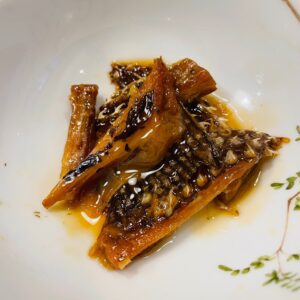
“Warabi no Ippon-zuke (Pickled bracken)” is also a local dish of Yamagata prefecture. Yamagata Prefecture is the largest producer of bracken in Japan, and its market share exceeds 50%. I love bracken, so I enjoyed the pickled bracken.

2. Ekiben
After having a local dish of Yamagata prefecture at “FURUSAWA SAKE BREWERY Sawa Masamune”, I had ekiben on the Yamagata Shinkansen. I like traveling by train, and I love the ekiben on the train.
I ate “Beef Domannaka”. It’s a specialty of Yonezawa, but I bought it at Yamagata Station because it’s my favorite ekiben. “Beef Domannaka” is a well-known ekiben nationwide that was selected as the No. 1 ekiben in East Japan in 2013. I was very satisfied with the ekiben with beef soboro and beef simmered on top of Yamagata prefecture’s brand rice “Domannaka”.
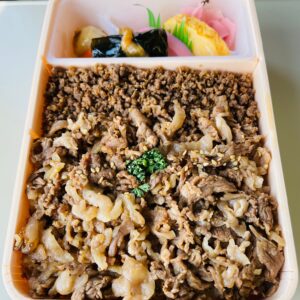
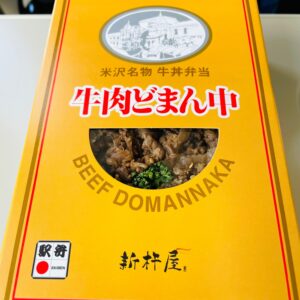
Besides, I had “Michinoku Bento Journey”. This ekiben was also a delicious lunch. There is a microwave oven at the ekiben shop in Yamagata station, so I’m glad that we can eat hot ekiben on the train.
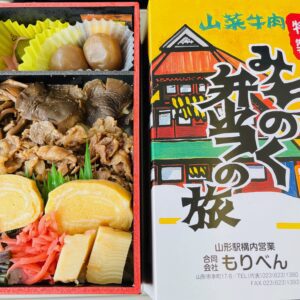
The ekiben that I ate while watching the snowy scenery from the train window of the Yamagata Shinkansen was the best.

3. Local beer, local sake
After arriving at Ginzan Onsen, I bought craft beer and local sake at “Yagihashi Shoten” and enjoyed it at Notoya Ryokan. “Yagihashi Shoten” is a recommended liquor store with a large selection of sake.

Yamagata Prefecture is famous for sake production and is ranked 6th in the ranking by prefecture. There are many famous sakes such as “Juyondai”, “Kudokijozu”, “Jokigen”, and “Hatsumago”. Yamagata Prefecture is also developing “Dewa San San” and “Dewa no Sato”, which are suitable rice for sake brewing. “Koten” in the photo below is a local sake from Otokoyama Sake Brewery (Yamagata City) that uses “Dewa San San” as the raw material rice. I bought “Koten” at Yamagata Station.

“Yamagata Masamune” of Mitobe Sake Brewery (Tendo City), which uses Okayama Prefecture’s Omachi as the raw material rice, was also a delicious sake of “Usunigori”. There was also the original Ginzan Onsen sake from “Yagihashi Shoten”.
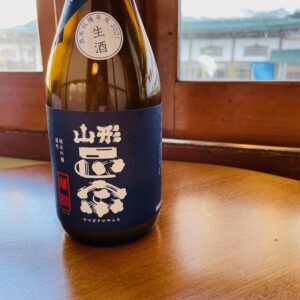

4. Notoya Ryokan
I had dinner in the room of Notoya Ryokan. It was a very satisfying dinner with a huge amount. If you look at the items in the picture below, you can understand the large amount of dinner. I think many people can’t eat it. I’m worried that many people won’t be able to eat and will have a lot of leftover food.

The shabu-shabu of Obanazawa beef and Yonezawa pork was the best.
The climate nurtures the deliciousness of Obanazawa beef. Obanazawa City, where Ginzan Onsen is located, rises to nearly 40 degrees Celsius in summer and becomes a harsh environment of -10 degrees Celsius or less in winter. Cows naturally acquire fat in order to overcome this harsh environment of temperature difference. This finest fat is the source of the deliciousness of Obanazawa beef. According to the Obanazawa Beef Promotion Council, Obanazawa beef is only offered at 4 inns at Ginzan Onsen.
Yonezawa pork was also delicious pork with sweet fat. “Pork” is the third largest agricultural output in Yamagata prefecture after “rice” and “cherries”. There are “Yonezawa Pork Ichiban Sodachi”, “Tengen Pork”, “Yonezawa Sangen Pork”, etc. in the Yonezawa area.
By the way, Sangen pig means a hybrid pig (LWD) that is a combination of three types of purebred pigs: Landrace pig (L), Large White pig (W), and Duroc pig (D). There are also combinations of Sangen pigs other than LWD. Pigs that are a combination of four purebreds are called Yongen pigs (also called hybrid pigs). Most of the edible pigs produced in Japan are Sangen pigs.
 “Koi no Uma-Ni” is a local dish of Yamagata prefecture that is made by cutting carp into slices and boiling them with sugar, soy sauce, and sake. It is also introduced in “Our Regional Cuisines” by the Ministry of Agriculture, Forestry and Fisheries. The volume of “Koi no Uma-Ni” was amazing.
“Koi no Uma-Ni” is a local dish of Yamagata prefecture that is made by cutting carp into slices and boiling them with sugar, soy sauce, and sake. It is also introduced in “Our Regional Cuisines” by the Ministry of Agriculture, Forestry and Fisheries. The volume of “Koi no Uma-Ni” was amazing.

The Dengaku of char was a little sweet, but I’m glad I was able to eat the char for the first time in a while.

The duck soup was also hot and delicious.

Note: The departure / arrival times, fares, admission fees, meal fees, etc. of transportation listed in the text are as of the time of writing the BLOG. Please check for yourself when you go on a trip as it may change in the future.